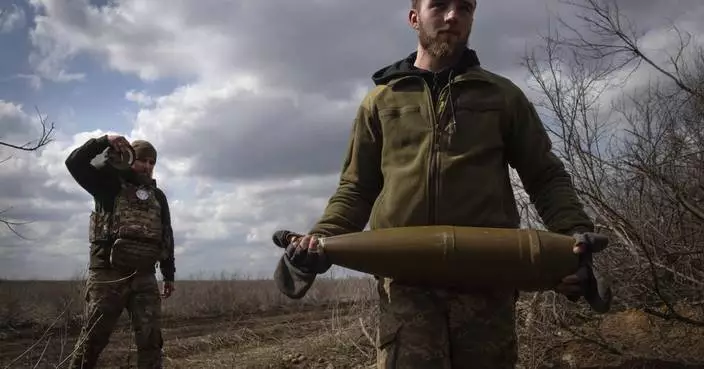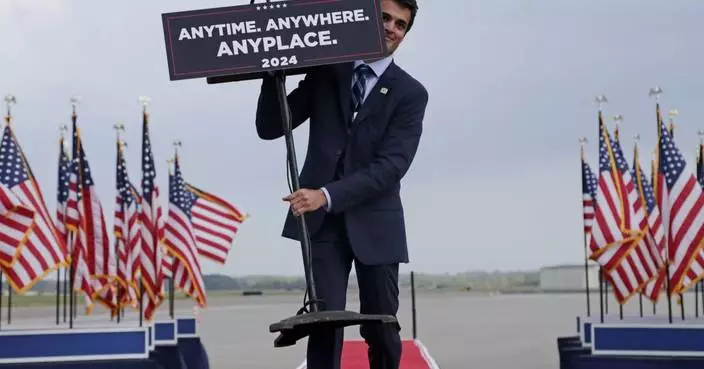The U.S. border wall with Mexico is frequently in the news, but few people have a chance to visit it up close, or to see details of the various sections.
Kenneth Madsen, an Ohio State University geography professor and border wall expert, hopes his new photo exhibit will help bring the border closer to people at a time of heated discussion about the role of the wall, and of barriers in society overall.
"Up Close with U.S.-Mexico Border Barriers" opens Wednesday at the LeFevre Art Gallery on the Ohio State campus in Newark, 40 miles (64 kilometers) east of Columbus. The free exhibit of 33 poster-sized pictures features border wall photos and maps.
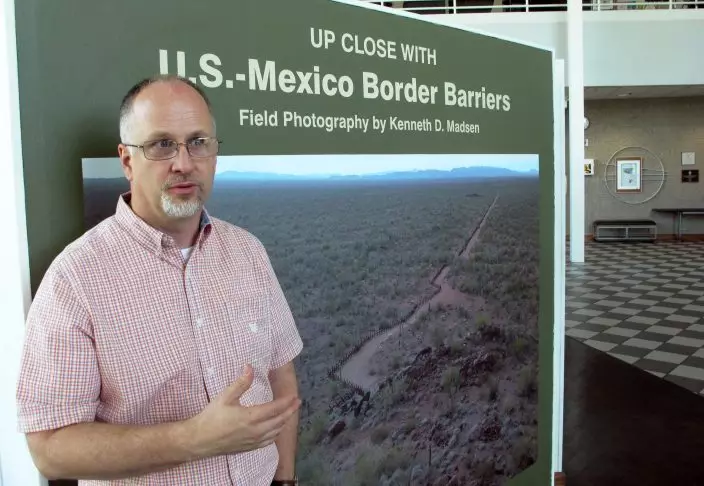
In this Friday, Sept. 14, 2018, photo, Kenneth Madsen, an Ohio State University-Newark geography professor and border wall expert, discusses his photo exhibit of border wall pictures and maps, "Up Close with U.S.-Mexico Border Barriers," in Newark, Ohio. Madsen says the goal of his exhibit, opening Wednesday, Sept. 19 is to raise awareness about an issue that most people have only seen on the news. (AP PhotoAndrew Welsh-Huggins)
One of the exhibit's goals is creating awareness about the wall, which can include low-grade sections in rural areas meant to stop vehicles and much stronger barriers in cities meant to stop people, Madsen said.
"People don't generally have a chance to see something up close, at that level of detail, to know what's going on out there," he said.
President Donald Trump has held out the possibility of a government shutdown before the November elections over his effort to build a wall on the U.S.-Mexico border, even as Republican congressional leaders publicly urged him away from that path and predicted it wouldn't occur. "Build the wall!" was a frequent rallying cry during Trump's 2016 campaign.
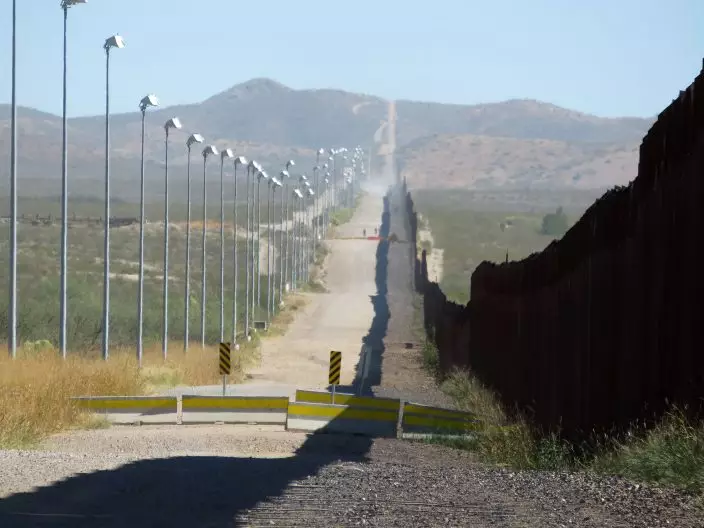
In this Nov. 15, 2016, photo provided by Kenneth Madsen, stadium lights atop tall poles oversee a pedestrian barrier stretching for miles along a section of the border wall between Douglas, Arizona, and Agua Prieta, in the Mexican state of Sonora. A new photo exhibit by Madsen opening Wednesday, Sept. 19, 2018, at the Ohio State University-Newark campus, "Up Close with U.S.-Mexico Border Barriers,” highlights different types of border wall fencing. (Kenneth Madsen via AP)
Madsen has studied the border wall since his graduate school days 20 years ago. His photo exhibit consists of pictures taken with his iPhone mostly in 2017, when he was on sabbatical.
In one image, children play at a Mexican playground beside a barrier in Tijuana near the Pacific Ocean while a U.S. border agent watches from his SUV on the American side just a couple of hundred feet away.
In another, stadium lights atop tall poles oversee a pedestrian barrier stretching for miles along a section of the wall between Douglas, Arizona, and Agua Prieta in the Mexican state of Sonora.
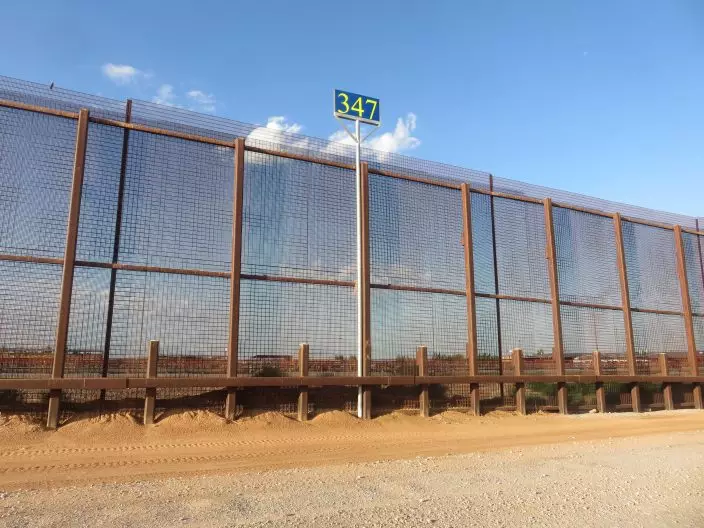
In this July 27, 2017, photo provided by Kenneth Madsen, a pedestrian barrier with a vehicle barrier overlay on the bottom sits about a mile east of the Santa Teresa, Mexico, port of entry at the site of a livestock crossing. A new photo exhibit by Madsen opening Wednesday, Sept. 19, 2018, at the Ohio State University-Newark campus, "Up Close with U.S.-Mexico Border Barriers,” highlights different types of border wall fencing. (Kenneth Madsen via AP)
In a third, a post-on-rail type wall snakes through a Colorado River flood plain between Arizona and Baja California in Mexico, a design meant to minimize soil disturbance in fragile landscapes, as well as to prevent it being washed away in a flood.
U.S. communities tend to grow away from the border wall, while Mexican communities tend to hug them up close, Madsen said. That helps account for large murals or brightly painted panels along several sections on the Mexican side.
Madsen is also an expert on waivers along the wall, whereby the government can exempt fence construction from a variety of federal requirements, including archaeological and environmental surveys.
Madsen plans to attend an international conference on border walls next week in Montreal.
Another border expert attending that conference says it's important to share the experience of the border with people through such exhibits because so many stereotypes about the wall are wrong.
"The social construction of the border is negative and it's perpetuated by people that have never even seen it, been here, touched it, felt it, crossed it," said Irasema Coronado, a political science professor at the University of Texas-El Paso and a past president of the Association for Borderland Studies.
Madsen's exhibit isn't overtly political, and provides useful information for people on both sides of the border debate. But he notes the irony that wall building has increased with the rise of globalization.
Though the free-flow of capital means more freedom for more people, "there also are these border walls and fences to restrict movement of people of lesser economic means with fewer opportunities available, who are maybe stuck in bad situations," he said.
Andrew Welsh-Huggins can be reached on Twitter at https://twitter.com/awhcolumbus.
UNITED NATIONS (AP) — Russia on Wednesday vetoed a U.N. resolution sponsored by the United States and Japan calling on all nations to prevent a dangerous nuclear arms race in outer space, calling it “a dirty spectacle” that cherry picks weapons of mass destruction from all other weapons that should also be banned.
The vote in the 15-member Security Council was 13 in favor, Russia opposed and China abstaining.
The resolution would have called on all countries not to develop or deploy nuclear arms or other weapons of mass destruction in space, as banned under a 1967 international treaty that included the U.S. and Russia, and to agree to the need to verify compliance.
U.S. Ambassador Linda Thomas-Greenfield said after the vote that Russian President Vladimir Putin has said Moscow has no intention of deploying nuclear weapons in space.
“Today’s veto begs the question: Why? Why, if you are following the rules, would you not support a resolution that reaffirms them? What could you possibly be hiding,” she asked. “It’s baffling. And it’s a shame.”
Russia’s U.N. Ambassador Vassily Nebenzia dismissed the resolution as “absolutely absurd and politicized,” and said it didn’t go far enough in banning all types of weapons in space.
Russia and China proposed an amendment to the U.S.-Japan draft that would call on all countries, especially those with major space capabilities, “to prevent for all time the placement of weapons in outer space, and the threat of use of force in outer spaces.”
The vote was 7 countries in favor, 7 against, and one abstention and the amendment was defeated because it failed to get the minimum 9 “yes” votes required for adoption.
The U.S. opposed the amendment, and after the vote Nebenzia addressed the U.S. ambassador saying: “We want a ban on the placement of weapons of any kind in outer space, not just WMDs (weapons of mass destruction). But you don’t want that. And let me ask you that very same question. Why?”
He said much of the U.S. and Japan’s actions become clear “if we recall that the U.S. and their allies announced some time ago plans to place weapons … in outer space.”
Nebenzia accused the U.S. of blocking a Russian-Chinese proposal since 2008 for a treaty against putting weapons in outer space.
Thomas-Greenfield accused Russia of undermining global treaties to prevent the spread of nuclear weapons, irresponsibly invoking “dangerous nuclear rhetoric,” walking away from several of its arms control obligations, and refusing to engage “in substantive discussions around arms control or risk reduction.”
She called Wednesday’s vote “a real missed opportunity to rebuild much-needed trust in existing arms control obligations.”
Thomas-Greenfield’s announcement of the resolution on March 18 followed White House confirmation in February that Russia has obtained a “troubling” anti-satellite weapon capability, although such a weapon is not operational yet.
Putin declared later that Moscow has no intention of deploying nuclear weapons in space, claiming that the country has only developed space capabilities similar to those of the U.S.
Thomas-Greenfield said before the vote that the world is just beginning to understand “the catastrophic ramifications of a nuclear explosion in space.”
It could destroy “thousands of satellites operated by countries and companies around the world — and wipe out the vital communications, scientific, meteorological, agricultural, commercial, and national security services we all depend on,” she said.
The defeated draft resolution said “the prevention of an arms race in outer space would avert a grave danger for international peace and security.” It would have urged all countries carrying out activities in exploring and using outer space to comply with international law and the U.N. Charter.
The draft would have affirmed that countries that ratified the 1967 Outer Space Treaty must comply with their obligations not to put in orbit around the Earth “any objects” with weapons of mass destruction, or install them “on celestial bodies, or station such weapons in outer space.”
The treaty, ratified by some 114 countries, including the U.S. and Russia, prohibits the deployment of “nuclear weapons or any other kinds of weapons of mass destruction” in orbit or the stationing of “weapons in outer space in any other manner.”
The draft resolution emphasized “the necessity of further measures, including political commitments and legally binding instruments, with appropriate and effective provisions for verification, to prevent an arms race in outer space in all its aspects.”
It reiterated that the U.N. Conference on Disarmament, based in Geneva, has the primary responsibility to negotiate agreements on preventing an arms race in outer space.
The 65-nation body has achieved few results and has largely devolved into a venue for countries to voice criticism of others’ weapons programs or defend their own. The draft resolution would have urged the conference “to adopt and implement a balanced and comprehensive program of work.”
At the March council meeting where the U.S.-Japan initiative was launched, U.N. Secretary-General António Guterres warned that “geopolitical tensions and mistrust have escalated the risk of nuclear warfare to its highest point in decades.”
He said the movie “Oppenheimer” about Robert Oppenheimer, who directed the U.S. project during World War II that developed the atomic bomb, “brought the harsh reality of nuclear doomsday to vivid life for millions around the world.”
“Humanity cannot survive a sequel to Oppenheimer,” the U.N. chief said.
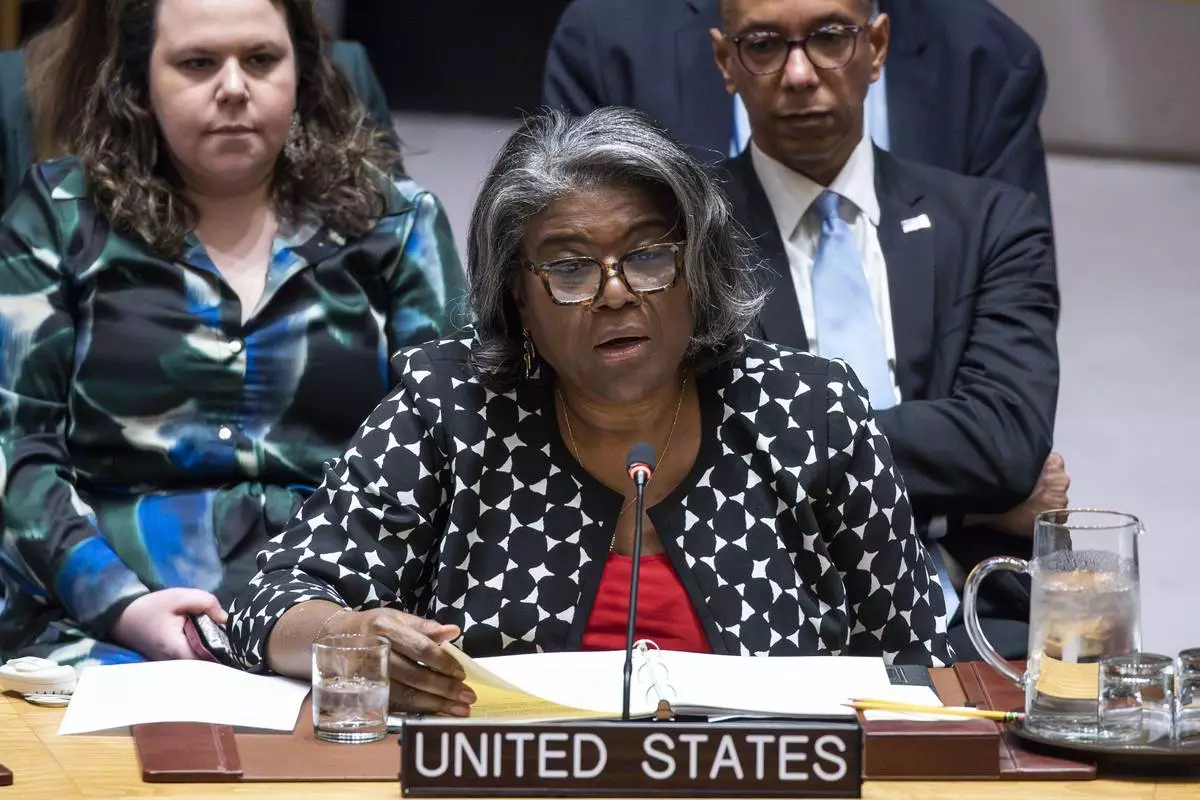
United States Ambassador and Representative to the United Nations Linda Thomas-Greenfield addresses members of the U.N. Security Council before voting during a meeting on Non-proliferation of nuclear weapons, Wednesday, April 24, 2024 at United Nations headquarters. (AP Photo/Eduardo Munoz Alvarez)
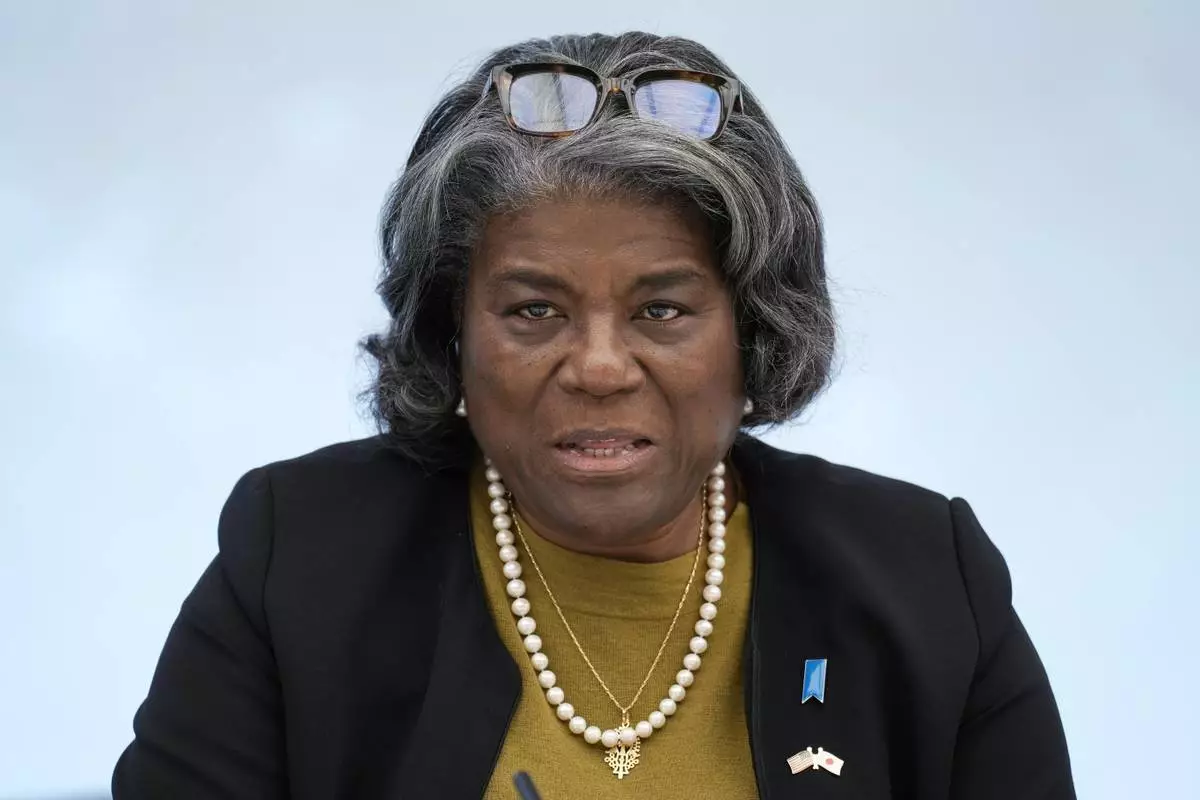
FILE - U.S. Ambassador to United Nations Linda Thomas-Greenfield speaks on Thursday, April 18, 2024, in Tokyo. The U.N. Security Council is set to vote Wednesday, April 24, 2024, on a resolution announced by Thomas-Greenfield, calling on all nations to prevent a dangerous nuclear arms race in outer space. It is likely to be vetoed by Russia. (AP Photo/Eugene Hoshiko, Pool, File)













